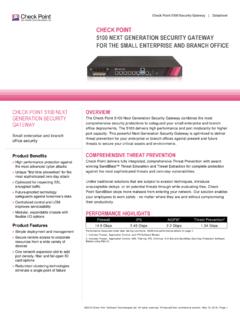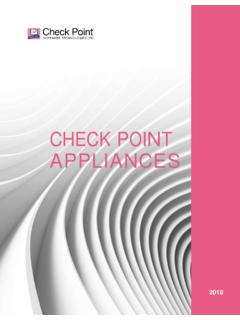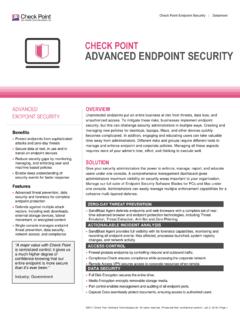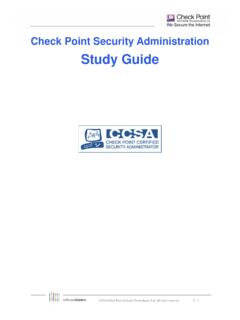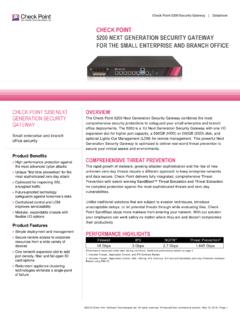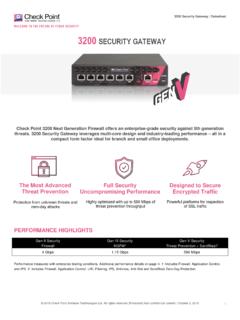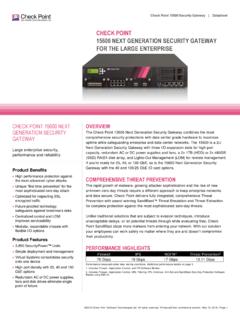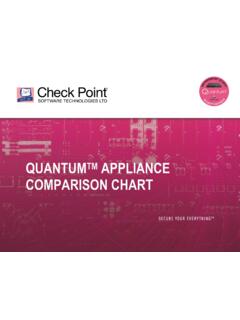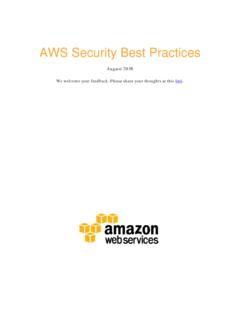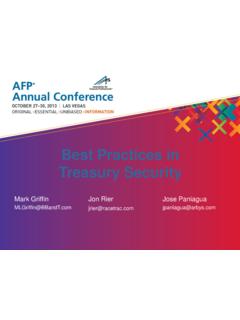Transcription of Top 10 Security Best Practices for Small Business
1 Top 10 Security best Practices for Small Business 2016 Check Point Software Technologies Ltd. [Protected] Non-confidential content 1. Small Business NEEDS. Security . TOO. What Are The Top 10 Security best Practices for Small Business ? 2016 Check Point Software Technologies Ltd. [Protected] Non-confidential content 2. Why Are Small Businesses Targeted? 83% of SMB Security incidents result in a confirmed data breach Verizon DBIR 2015. LARGE Small & MEDIUM. Business Business . Significant people Valuable information and budget for but weaker protection: high levels Less people and less of protection investment in Security 2016 Check Point Software Technologies Ltd. [Protected] Non-confidential content 3. Why Not Focus on Security ?
2 Too Small to be a target? Believe they have sufficient protection in place? Perception that cyber Security is too expensive and complex? A failure to protect against cyber threats could actually cause your Business to suddenly be out of Business . 2016 Check Point Software Technologies Ltd. [Protected] Non-confidential content 4. Top Security best Practice #1. #1: Common Passwords Are Bad Passwords Passwords are your first line of Security defense. Cybercriminals attempting to infiltrate your network will start by trying the most common passwords. SplashData uncovered the 25 most common passwords below. best PRACTICE: Ensure use of long (over 8 characters), complex (include lower case, upper case, numbers and non alpha characters) passwords.
3 The 25 Most Common Passwords (If you have one of these, change it NOW!). 1. password 10. baseball 19. ashley 2. 123456 11. iloveyou 20. football 3. 12345678 12. trustno1 21. jesus 4. abc123 13. 1234567 22. michael 5. qwerty 14. sunshine 23. ninja 6. monkey 15. master 24. mustang 7. letmein 16. 123123 25. password1. 8. dragon 17. welcome 9. 111111 18. shadow 2016 Check Point Software Technologies Ltd. [Protected] Non-confidential content 5. [Protected] Non-confidential content Top Security best Practice #2. #2: Secure Every Entrance All it takes is one open door to allow a cybercriminal to enter your network. Just like you secure your home by locking the front door, the back door and all the windows, think about protecting your network in the same way.
4 Consider all the ways someone could enter your network, then ensure that only authorized users can do so. Ensure strong passwords on laptops, smartphones, tablets, and WIFI access points. Use a Firewall with Threat Prevention to protect access to your network (like the Check Point 700 Appliance). Secure your endpoints (laptops, desktops) with Security software such as Anti-virus, Anti-SPAM and Anti-Phishing. Protect from a common attack method by instructing employees not to plug in unknown USB devices. 2016 Check Point Software Technologies Ltd. [Protected] Non-confidential content 6. [Protected] Non-confidential content Top Security best Practice #3. #3: Segment Your Network A way to protect your network is to separate your network into zones and protect the zones appropriately.
5 One zone may be for critical work only, where another may be a guest zone where customers can surf the internet, but not access your work network. Segment your network and place more rigid Security requirements where needed. Public facing web servers should not be allowed to access your internal network. You may allow guest access, but do not allow guests on your internal network. Consider separating your network according to various Business functions (customer records, Finance, general employees). 2016 Check Point Software Technologies Ltd. [Protected] Non-confidential content 7. [Protected] Non-confidential content Top Security best Practice #4. #4: Define, Educate and Enforce Policy Actually HAVE a Security policy (many Small businesses don't) and use your Threat Prevention device to its full capacity.
6 Spend some time thinking about what applications you want to allow in your network and what apps you do NOT. want to run in your network. Educate your employees on acceptable use of the company network. Make it official. Then enforce it where you can. Monitor for policy violations and excessive bandwidth use. Set up an Appropriate Use Policy for allowed/disallowed apps and websites. Do not allow risky applications such as Bit Torrent or other Peer-to-Peer file sharing applications, which are a very common methods of distributing malicious software. Block TOR and other anonymizers that seek to hide behavior or circumvent Security . Think about Social Media while developing policy. 2016 Check Point Software Technologies Ltd.
7 [Protected] Non-confidential content 8. [Protected] Non-confidential content Top Security best Practice #5. #5: Be Socially Aware Social media sites are a gold mind for cybercriminals looking to gain information on people, improving their success rate for attacks. Attacks such as phishing, spearphish or social engineering all start with collecting personal data on individuals. Educate employees to be cautious with sharing on social media sites, even in their personal accounts. Let users know that cybercriminals build profiles of company employees to make phishing and social engineering attacks more successful. Train employees on privacy settings on social media sites to protect their personal information.
8 Users should be careful of what they share, since cybercriminals could guess Security answers (such as your dog's name) to reset passwords and gain access to accounts. 2016 Check Point Software Technologies Ltd. [Protected] Non-confidential content 9. [Protected] Non-confidential content Top Security best Practice #6. #6: Encrypt Everything One data breach could be devastating to your company or your reputation. Protect your data by encrypting sensitive data and make it easy for your employees to do so. Ensure encryption is part of your corporate policy. Sleep easy if laptops are lost or stolen by ensuring company owned laptops have pre-boot encryption installed. Buy hard drives and USB drives with encryption built in.
9 Use strong encryption on your wireless network (consider WPA2 with AES encryption). Protect your data from eavesdroppers by encrypting wireless communication using VPN. (Virtual Private Network). 2016 Check Point Software Technologies Ltd. [Protected] Non-confidential content 10. [Protected] Non-confidential content Top Security best Practice #7. #7: Maintain Your Network Like Your Car Your network, and all its connected components, should run like a well oiled machine. Regular maintenance will ensure it continues to roll along at peak performance and hit few speed bumps. Ensure operating systems of laptops and servers are updated (Windows Update is turned on for all Systems). Uninstall software that isn't needed so you don't have to check for regular updates ( , Java).
10 Update browser, Flash, Adobe and applications on your servers and laptops. Turn on automatic updates where available: Windows, Chrome, Firefox, Adobe. Use an Intrusion Prevention System (IPS) device like the Check Point 700 Appliance to prevent attacks on non- updated laptops. 2016 Check Point Software Technologies Ltd. [Protected] Non-confidential content 11. [Protected] Non-confidential content Top Security best Practice #8. #8: Cloud Caution Cloud storage and applications are all the rage, but be cautious. Any content that is moved to the cloud is no longer in your control. And cybercriminals are taking advantage of weaker Security of some Cloud providers. When using the Cloud, assume content sent is no longer private.
